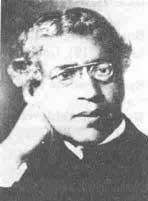


Antentop is FREE e-magazine devoted to Antennas and Amateur Radio an
Special page devoted to
Jagadis Chandra Bose

Custom Search
|
ANTENTOP-
02- 2003, # 003 |
Jagadis Chandra Bose |
||
|
|
|||
|
|
|||
|
|
Prof Rajesh Kochhar |
||
|
|
|
||
|
A 100 years after
Jagdish Chander Bose, India seems to have come to the painful
realization that it is unlikely to make any worthwhile scientific
inventions any more. It has therefore decided to invent a J.C. Bose that did not
exist before. This Bose cannot be patented internationally but
can certainly be put to good use in the domestic and NRI market.
Bose is one of the founding fathers of radio-physics, whose research
acted as a bridge between the original discovery by Heinrich Rudolf
Hertz and practical use by Guglielmo Marconi. Marconi shared the 1909 physics Nobel prize. Had Hertz been alive {he died in 1894), then he would probably have been similarly honoured. |
Jagdish Chander Bose
|
||
|
Did Marconi cheat Bose? A story in The
Telegraph (December 1997) carried the rather sensational
title "Bose
invented Marconi's wireless". The story was
based on a recent report by some US- based Indian engineers
that the detecting device (or coherer as it was then called) that
Marconi used, the so- called Italian navy coherer, was modified
from an instrument invented by Bose two years previously. The story asserted rather ingeniously that "so far, his (Bose's)
reputation has rested on his botanical work." It quoted a
scientist associated with the project as saying, "
A combination of factors like naivete about patenting,
plain misfortune and poli- tics of the contemporary times weighed
against Bose." This assessment is unhistorical and an exercise in time-warp. It presents
Bose II a victim of circumstances and conspiracies which he was
not. It seeks to assign to Bose and his associates motivations
and aspirations that did not exist then, but are an after thought.
It attempts to evaluate Bose in a time-frame that came into being
later and which Bose could not have anticipated. It is on record that Europe's encouragement to, support for and recognition
of Bose's pioneering research were unstinted and spontaneous.
He was offered a professorship at Cambridge University. He
was the first professionally trained mainstream Indian scientist
to be elected a fellow of the prestigious
Royal Society of London. He was fully
aware of the commercial implication of his radio work and conscientiously
wanted no part of it. As for Marconi, he was literally on a different
wavelength. From 1894 till about 1900, Bose studied
the optical properties of radio waves. |
Value of his
work lies in his experimental innovations. He modified old detectors
and made new ones. In addition, he tested a wide variety of materials
for the purpose because metals would get easily oxidized "in
the warm and damp climate of Bengal". As
early as 1895, Bose demonstrated to an excited Calcutta audience
the wireless Transmission of radio waves over a distance of 75
feet (25 m) through masonry. Bose's waves were microwaves with
Lengths in the millimetre range. For travel through long distances in space one need
longer radio waves. Their study was initiated by A.S. Popoff in Russia and profitably taken up by
Marconi. For
his detectors, he like every body else, made use of Bose's researches
which were already published and therefore common property.
It would be unfair to grudge Marconi
his practical and commercial success. After all,
both he and Bose achieved what they aspired for. Bose presented
his first results before the Asiatic Society, Calcutta, in May
1895. According to the pioneering Indian chemist, Prafulla Chandra
Ray, who was colleague and close friend
of Bose, "It appears that he had not then realised the importance
of the new line of research he had hit upon." Bose sent copies of his research paper to his former teacher Lord
Rayleigh and to Lord Kelvin, both of whom immediately saw its
worth. Bose went on a lecturing tour of England and Europe during
1896-1897 and then again during 1900-1902 when he visited the
US also. After his public lecture in 1897 at the Royal Institution
in London, he expressed "surprise that no secret was at
any time made as to its (coherer's) construction, so that it has
been open to all the world to adopt it
for practical and possibly money-making purposes".
An early admirer of the Bose coherer was the British navy, which
used it to establish effective radio link between a torpedo boat
and friendly ships. |
||
|
|
|
||
|
Page 97 |
|||
97 98
 |
 |
 |
 |
Just for Fun:

Powered byIP2Location.com
Thanks for your time!
Last Updated:
March 8, 2020 13:19





